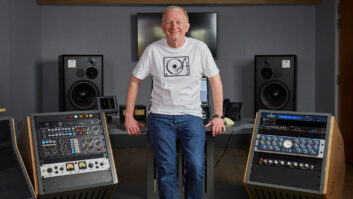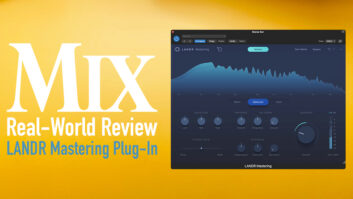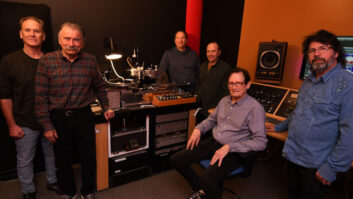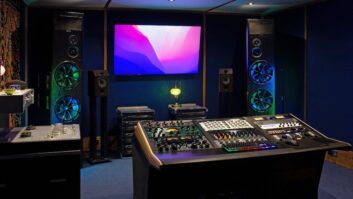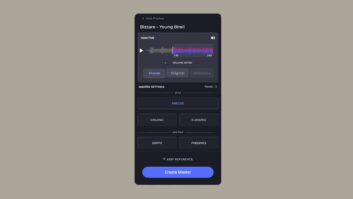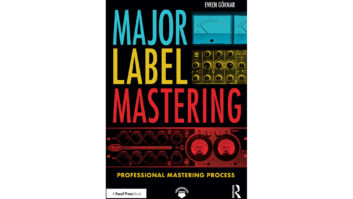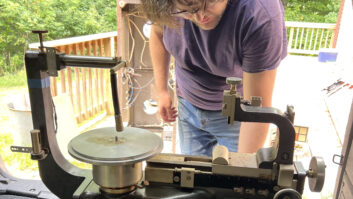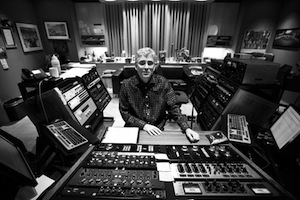
We should all give thanks for mastering engineers. Despite small budgets, low-resolution distribution, level wars and the DIY democratization of the recording business, the engineers on the back end of record making are still on the front lines in the fight to protect the sonic integrity of our music. It’s inspiring to see the ways these pros serve as leaders, helping to develop standards and practices for high-res downloads, mentoring newer engineers, and educating clients about ways to make their music the best it can be.
Last year, Mix’s annual mastering issue focused on the then-new Mastered for iTunes encoding method (MFiT), which is now standard-issue for the five iconic engineers we talked to this year to get an image of the mastering industry today: Doug Sax of The Mastering Lab, Bernie Grundman of Grundman Mastering, Hank Williams of MasterMix, Greg Calbi of Sterling Sound and Bob Ludwig of Gateway Mastering.
All of these engineers are working on the cutting edge of the business, dealing with many of the same issues in their daily work. Here, we focus on the topics they consider critical to mastering, and the state of music listening in general.
Greg Calbi: Real-World Mastering
Sterling Sound co-owner Greg Calbi has been mastering in New York City for more than 40 years, so he’s seen the industry at its highest and lowest points, financially speaking. As someone whose projects range from The Beatles to home recordists, he thinks it’s essential to remember that no matter what the format du jour is, the mastering engineer’s job remains the same—especially when the client has limited experience and funds.
“The nuts and bolts of this business are artists who need to enhance the quality of a recording that is usually under-budgeted and has been worked on by people who are possibly not particularly experienced and need that next level of help,” Calbi says. “They may not be able to take their band into a commercial recording studio. They may not even be able to have a professional mix it, but usually there’s enough budget to be able to come to a professional mastering studio.
“We have clients who are Lady Gaga-level, Adele-level, but I do maybe 150 to 200 albums a year, so the 10 albums that will sell over half a million are one thing, but the other 150 or so records that come out are a different story. To me, this is the most significant change in our business in recent years: It’s an entirely different type of person coming to us. It’s a guy and his girlfriend who are managing themselves. They’re producing themselves. They’re recording themselves, but they’re not engineers. The person who’s trying to develop now as a songwriter and a music creator in this environment—you have to know that it’s a very taxing and high-energy and low-paying situation that these kids come into and try to be successful.”
For these reasons, and others, Calbi feels that educating clients has never been more important. To whatever degree is necessary, he explains the mastering process to clients who will then take the knowledge he’s given them and go into their next project better informed. “It’s an entirely fluid situation of trying to understand what the client’s need is and trying to have a critical yet positive reaction to the work, and trying to enhance it to the best of my ability without really discouraging the client,” Calbi says. “But it’s so satisfying when people call you up and say they can really hear the difference you made in their recordings, and they feel they really got value for the money that they put in, often at a real sacrifice.”

Bernie Grundman: Fighting the Good Fight
With locations in Hollywood and Tokyo, Bernie Grundman’s longtime mastering business serves a huge variety of clients. His long career has made him a bit philosophical about the lowered standards of listeners, who he says seem mainly to put music in the background of their busy lives. “It’s the fast-pace lifestyle. People have so many distractions, and music has become a different thing in their lives,” he says.
This appears to be one of the reasons that artists and labels are so desperate to be noticed, and consequently turn the volume up, and up. “They figure if it gets people’s attention, there’s a better chance of selling the recording,” Grundman says. “So let’s make everything really loud and use all the processors to just slam this thing against the ceiling as loud as we can get it. It jumps out and, boom, it’s harsh and bright and it gets your attention, but before long—after two or three tunes—you’re exhausted.
“This isn’t new, but it’s ongoing,” he continues. “All the mastering engineers complain about it, but the industry and the artists and producers are concerned. If their song doesn’t come on as strong as somebody else’s, they’re afraid they won’t be heard. The problem is, sometimes there’s so much processing that even when you turn it down, it’s too aggressive, too harsh, too metallic, too grainy, too smeary. Many recordings actually sound mechanical now—like a machine. It’s a real conflict between the commercial side—people feeling that they need to be aggressive—and what the public would actually enjoy hearing.
“Of course, these recordings are examples of what happens if things get out of hand. There are also many recordings on which good judgment was used, and they retain their musicality and are still competitive. Good mastering that serves the music is where the priority should be.
“I tell them, as a mastering engineer, there’s a limitation on how loud I can make this,” he says. “I can do a lot of processing, but that will squash everything and make it less musical. If level is important, I tell mixers to put on a CD they really like—something that plays well everywhere. Put that up and look at the same meters that you used and see what the different parameters are: the peak level, the average level, etc. Ask yourself: ‘How’s it reading?’ Then set a comfortable listening level. Now, here is the key: Take down the monitor level control. You’re not going to touch that level control again. You’re going to say, ‘I’m going to make my record sound like this, with the same volume control setting.’ Keep in mind: you will want to be a little lower in average level to leave room for the needed limiting and compression in mastering.
“This is why I call mastering the sobering part of the business. When you crank your music up loud, you get a physical tension and a sense of power and excitement that you could mistakenly attribute to the music. When your recording is out in the world, you won’t be there to turn it up to get extra excitement; it has to stand on its own, next to all the others.”

Hank Williams: A World of Music
When we contacted Hank Williams in his Nashville studio, one of his projects—Blake Shelton’s album Based on a True Story—had just won the CMA for album of the year. Williams has mastered releases for some of the biggest stars of country and beyond, and more and more, his work comes from far beyond the friendly confines of Music City.
“I’d have to say that for me, the thing that has been the most exciting and the most interesting development over the past three or four years has been that the world has gotten so much smaller,” Williams says. “It’s just so much fun to be able to work with people from all over the world now. Today, the project I’m working on comes from Vancouver. The market has really opened up for us. It’s no longer just about the Southeast or even the U.S. for us. Our work is coming from continental Europe and Canada—all over.”
Williams isn’t thrilled with all of the industry changes he’s seen, however. He says that though mastering engineers celebrate the public’s interest in high-res downloads, his best efforts are sometimes undone by poor quality control and/or communication from labels.
“For example, I more often than not find out on the back side that something I mastered has gone to vinyl,” Williams says, “and we miss the opportunity to provide a better-resolution version to the disc-cutting people. That’s really frustrating for me and frustrating on behalf of my clients that the record company did not give them the opportunity to provide something higher-resolution than a 44.1/16-bit CD master. It’s especially annoying to me, because at MasterMix, there’s always a 24-bit version here of the project that could yield better resolution, and on some projects there’s higher-resolution sample rates also. I love working in high-res, but I don’t love working in high-res and then having it dumbed down at the end.”
Between pushing back on loud mixes and struggling for better communication from labels (which are likely as understaffed as any type of business these days), Williams and his colleagues here admit that they can find themselves somewhat at odds with clients—walking a line between standing up for quality and simply giving clients what they want. “We try to educate our clients on some of the issues that mixing extremely hot mixes can bring,” Williams says. “But in the end I’m here to serve my clients. I will always voice my opinion, but they may not always take it.”

Bob Ludwig with the band Lucius
Bob Ludwig: Formats on the Verge
Our interview with Bob Ludwig took place a few weeks after fall AES, where Ludwig led his annual Platinum Mastering Panel to discuss issues and developments that affect all mastering engineers. Like the other pros included here (Calbi and Sax were also on the panel), Ludwig has long embraced a leadership role in the industry, consulting with developers on new technologies, and advocating for high-quality music delivery. High-res downloads may still be finding their footing in the market, but Ludwig is more than ready to turn them out whenever there’s public interest.
“Since 2005 at least, I’ve always mastered everything at the same resolution that was sent to me, so I have a big archive of high-res files of projects I’ve done,” Ludwig says. “The record companies are thrilled to hear that they don’t have to pay me to re-master something—they can use the high-res files I created five years ago. I’m thrilled that consumers who are interested can go and spend the extra money on high-res digital, and I’m also really thrilled about the Mastered for iTunes initiative, because that has brought the possibility of really good sound for downloads among the 450 million iOS devices that are out there in the world.”
However, Ludwig has a message for engineers who are new to mastering for iTunes: “The Mastered-for-iTunes process, which is called ‘afclip,’ measures the amount of distortions, or clips, as a result of the encoding process, which leads to lowering the level into the encoder from a 24-bit source instead of 16,” he says. “In addition to just making sure that there’s no distortion from the clip, it turns out that there’s an aesthetic that a lot of mastering studios seem to not be aware of, which is that just because there’s no clipping doesn’t mean it’s making the best-sounding encode. Sometimes lowering it another half dB or another dB into the encoder gives you a lot more air around, ironically, the low frequencies—the bass and the kick drum—which makes for a less squashed-sounding download. During my panel I found out that a lot of people would simply lower the level until there was no clipping without realizing that further lowering it made it sound yet better.
“Apple is trying to do good,” he continues. “They’re definitely trying to make the masses’ experiences as good as they can. Right now all your iPhones and iPads and iPods only play either 48k or 44.1 natively. They’ll play higher-resolution files, but it down-samples to either 44.1 or 48. But things are going to keep improving, and I’m sure Apple would be delighted to resell 450 million iOS devices that can play 96k, natively, you know?”

Doug Sax: The Vinyl Word
When he was invited to sit on Ludwig’s Platinum Mastering Panel this year, Doug Sax suggested they discuss mastering for multiple formats. “Ten years ago, you made a CD master and you were done,” Sax says. “Now you do a CD master, a master for iTunes, a high-resolution master for HDtracks, and a cutting master for vinyl.”
To Sax—who has weathered every shift in his business since opening his first Mastering Lab studio in 1967—the slow but steadily growing vinyl business has been the most surprising part of the format equation.
“I had parked my lathes in storage in 2000,” Sax says. “Then several years ago, some clients started ordering cutting masters for vinyl. I had to feel that it was real [before bringing back the lathes], though, because the amount of money we had to spend to restore them and build a room for them was considerable. But it is real.”
Sax brought those custom lathes back to his studio in 2009. At first, they mainly saw reissue work, which is still part of the vinyl attraction. Last year, Sax remastered Pink Floyd’s The Wall, which he mastered originally in 1979. This year, he remastered a Doors limited-edition LP (on Rhino Records) for Record Store Day.
“But now we’re also doing vinyl for new groups,” Sax says. “Jaymes Quirino, who books our studio, says it’s about 50 to 60 percent of our clients, in all genres, that say, ‘I want a CD master, I want it mastered for iTunes, and I want vinyl.’”
Sax recently toured the Rainbo Records duplication/pressing plant, where general manager Steve Sheldon suggested that the vinyl increase Sax has observed is not unique to The Mastering Lab. “Billboard predicts, based on SoundScan numbers, that there will be about 5 million vinyl units sold this year,” Sheldon says. “But we pressed about 6 million in the past year, and that’s just our plant.”
Mastering for vinyl still comprises a fraction of The Mastering Lab’s business, but it’s an area of growth where Sax is uniquely qualified. “I’m hoping to increase the amount of vinyl cutting we do from other houses,” he says. “This is unusual, but we’re reaching out to other mastering studios, saying, ‘If you need to put out vinyl, and you don’t want to lose the quality once you make a great-sounding file, we’re your guys.’
“I think it’s exciting times,” Sax continues. “I don’t think it would mean anything to anybody if it was people my age all of a sudden deciding to play phonograph records again. But we’re hearing that the buyers of new turntables are 18 to 25 years old, and that’s the demographic that everyone would like to reach. When I talk to kids who are doing this, they’ll say, ‘I don’t know what it is, but I get more into the music.’ And of course, I’m thinking it’s because you’re not playing a videogame at the same time. It’s because you’re actually sitting down and devoting time to listening to music.”
